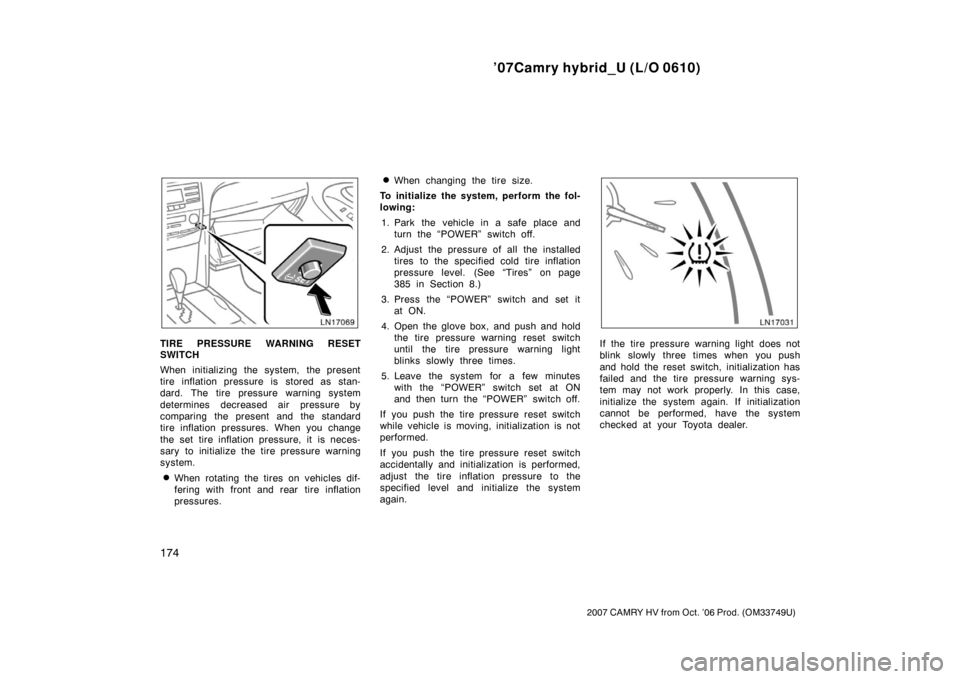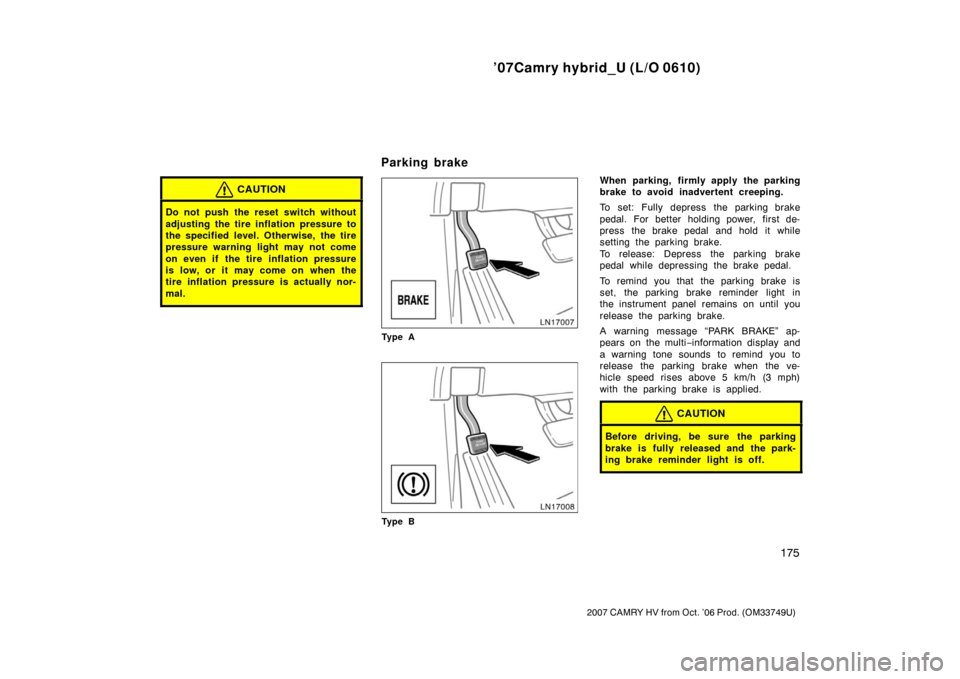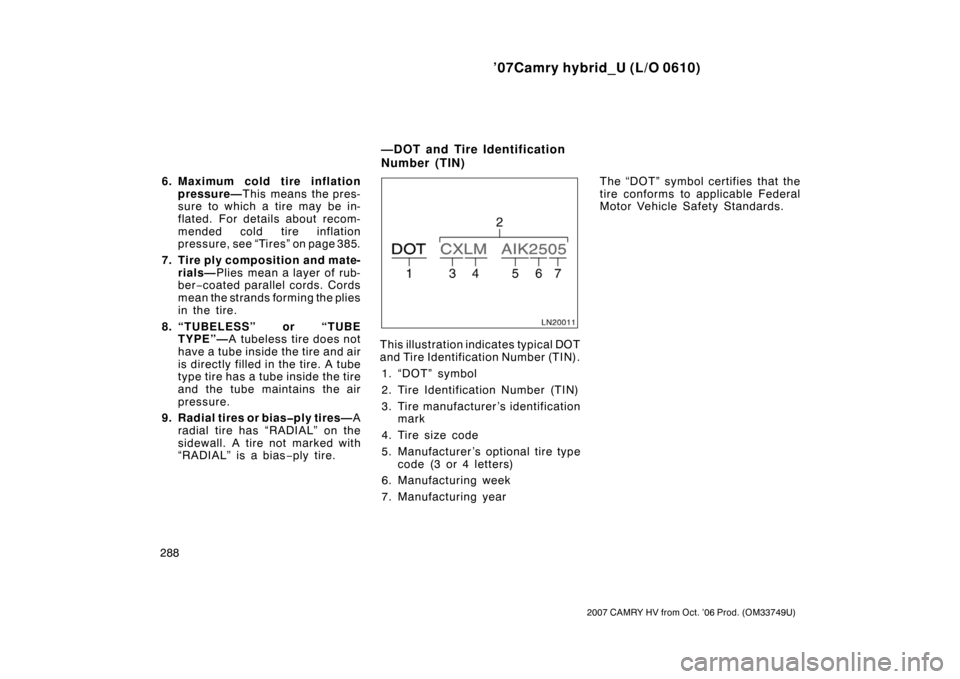Page 186 of 405

’07Camry hybrid_U (L/O 0610)
174
2007 CAMRY HV from Oct. ’06 Prod. (OM33749U)
TIRE PRESSURE WARNING RESET
SWITCH
When initializing the system, the present
tire inflation pressure is stored as stan-
dard. The tire pressure warning system
determines decreased air pressure by
comparing the present and the standard
tire inflation pressures. When you change
the set tire inflation pressure, it is neces-
sary to initialize the tire pressure warning
system.
�When rotating the tires on vehicles dif-
fering with front and rear tire inflation
pressures.
�When changing the tire size.
To initialize the system, perform the fol-
lowing: 1. Park the vehicle in a safe place and turn the “POWER” switch off.
2. Adjust the pressure of all the installed tires to the specified cold tire inflation
pressure level. (See “Tires” on page
385 in Section 8.)
3. Press the “POWER” switch and set it at ON.
4. Open the glove box, and push and hold the tire pressure warning reset switch
until the tire pressure warning light
blinks slowly three times.
5. Leave the system for a few minutes with the “POWER” switch set at ON
and then turn the “POWER” switch off.
If you push the tire pressure reset switch
while vehicle is moving, initialization is not
performed.
If you push the tire pressure reset switch
accidentally and initialization is performed,
adjust the tire inflation pressure to the
specified level and initialize the system
again.
If the tire pressure warning light does not
blink slowly three times when you push
and hold the reset switch, initialization has
failed and the tire pressure warning sys-
tem may not work properly. In this case,
initialize the system again. If initialization
cannot be performed, have the system
checked at your Toyota dealer.
Page 187 of 405

’07Camry hybrid_U (L/O 0610)
175
2007 CAMRY HV from Oct. ’06 Prod. (OM33749U)
CAUTION
Do not push the reset switch without
adjusting the tire inflation pressure to
the specified level. Otherwise, the tire
pressure warning light may not come
on even if the tire inflation pressure
is low, or it may come on when the
tire inflation pressure is actually nor-
mal.
Ty p e A
Ty p e B
When parking, firmly apply the parking
brake to avoid inadvertent creeping.
To set: Fully depress the parking brake
pedal. For better holding power, first de-
press the brake pedal and hold it while
setting the parking brake.
To release: Depress the parking brake
pedal while depressing the brake pedal.
To remind you that the parking brake is
set, the parking brake reminder light in
the instrument panel remains on until you
release the parking brake.
A warning message “PARK BRAKE” ap-
pears on the multi−information display and
a warning tone sounds to remind you to
release the parking brake when the ve-
hicle speed rises above 5 km/h (3 mph)
with the parking brake is applied.
CAUTION
Before driving, be sure the parking
brake is fully released and the park-
ing brake reminder light is off.
Parking brake
Page 298 of 405
’07Camry hybrid_U (L/O 0610)
286
2007 CAMRY HV from Oct. ’06 Prod. (OM33749U)
7. “TUBELESS” or “TUBETYPE”— A tubeless tire does not
have a tube inside the tire and air
is directly filled in the tire. A tube
type tire has a tube inside the tire
and the tube maintains the air
pressure.
8. Load limit at maximum cold tire inflation pressure— For details,
see “Checking and replacing tires”
on page 362.
9. Maximum cold tire inflation pressure— This means the pres-
sure to which a tire may be in-
flated. For details about recom-
mended cold tire inflation
pressure, see “Tires” on page 385.
10.Summer tire or all season tire— An all season tire has “M+S”
on the sidewall. The tire not
marked with “M+S” is a summer
tire. For details, see “Types of
tires” on page 298.
Page 299 of 405
’07Camry hybrid_U (L/O 0610)
287
2007 CAMRY HV from Oct. ’06 Prod. (OM33749U)
This illustration indicates typical tire
symbols.1. “TEMPORARY USE ONLY”— A
compact spare tire is identified by
the phrase “TEMPORARY USE
ONLY” molded into its sidewall.
This tire is designed for temporary
emergency use only. For details,
see “Compact spare tire” on page
319.
2. Tire size— F or det ails, see “— Ti re
size” on page 289.
3. DOT and Tire Identification Number (TIN)— For details, see
“—DOT and Tire Identification
Number (TIN)” on page 288.
4. The location of the tread wear indicators— For details, see
“Checking and replacing tires” on
page 362.
5. Load limit at maximum cold tire inflation pressure— For details,
see “Checking and replacing tires”
on page 362.
—Tire symbols (compact spare tire)
Page 300 of 405

’07Camry hybrid_U (L/O 0610)
288
2007 CAMRY HV from Oct. ’06 Prod. (OM33749U)
6. Maximum cold tire inflationpressure— This means the pres-
sure to which a tire may be in-
flated. For details about recom-
mended cold tire inflation
pressure, see “Tires” on page 385.
7. Tire ply composition and mate- rials— Plies mean a layer of rub-
ber −coated parallel cords. Cords
mean the strands forming the plies
in the tire.
8. “TUBELESS” or “TUBE TYPE”— A tubeless tire does not
have a tube inside the tire and air
is directly filled in the tire. A tube
type tire has a tube inside the tire
and the tube maintains the air
pressure.
9. Radial tires or bias�ply tires— A
radial tire has “RADIAL” on the
sidewall. A tire not marked with
“RADIAL” is a bias −ply tir e.
This illustration indicates typical DOT
and Tire Identification Number (TIN).
1. “DOT” symbol
2. Tire Identification Number (TIN)
3. Tire manufacturer ’s identification mark
4. Tire size code
5. Manufacturer ’s optional tire type code (3 or 4 letters)
6. Manufacturing week
7. Manufacturing year The “DOT” symbol certifies that the
tire conforms to applicable Federal
Motor Vehicle Safety Standards.
—DOT and Tire Identification
Number (TIN)
Page 303 of 405

’07Camry hybrid_U (L/O 0610)
291
2007 CAMRY HV from Oct. ’06 Prod. (OM33749U)
Temperature A, B, C—T he tem per a-
ture grades are A (the highest), B,
and C, representing the tire’s resis-
tance to the generation of heat and
its ability to dissipate heat when
tested under controlled conditions on
a specified indoor laboratory test
wheel. Sustained high temperature
can cause the material of the tire to
degenerate and reduce tire life, and
excessive temperature can lead to
sudden tire failure. The grade C cor-
responds to a level of performance
which all passenger car tires must
meet under the Federal Motor Vehicle
Safety Standard No.109. Grades B
and A represent higher levels of per-
formance on the laboratory test wheel
than the minimum required by law.
Warning: The temperature grades for
this tire are established for a tire that
is properly inflated and not over-
loaded. Excessive speed, underinfla-
tion, or excessive loading, either sep-
arately or in combination, can cause
heat buildup and possible tire failure.
Page 304 of 405

’07Camry hybrid_U (L/O 0610)
292
2007 CAMRY HV from Oct. ’06 Prod. (OM33749U)
Ti r e relat ed ter mMeaning
Accessory weight
the combined weight (in excess of those standard items which may be
replaced) of transaxle, power steering, power brakes, power windows,
power seats, radio, and heater, to the extent that these items are available
as factory−installed equipment (whether installed or not)
Cold tire inflation pressure
tire inflation pressure when the vehicle has been parked for at least 3
hours or more, or it has not been driven more than 1.5 km or 1 mile
under that condition
Curb weight
the weight of a motor vehicle wi th standard equipment including the
maximum capacity of fuel, oil, and coolant, and, if so equipped, air
conditioning and additional weight optional engine
Intended outboard sidewall
(A) the sidewall that contains a whitewall, bears white lettering or bears manufacturer, brand, and/or model name molding that is higher or
deeper than the same molding on th e other sidewall of the tire, or
(B) the outward facing sidewall of an asymmetrical tire that has a particular side that must always face outward when mounted on a vehicle
Maximum inflation pressurethe maximum cold inflation pressure to which a tire may be inflated and it
is shown on the sidewall of the tire
Maximum loaded vehicle weight
t he sum of —
(a) curb weight;
(b) accessory weight;
(c) vehicle capacity weight; and
(d) production options weight
—Glossary of tire terminology
Page 305 of 405

’07Camry hybrid_U (L/O 0610)
293
2007 CAMRY HV from Oct. ’06 Prod. (OM33749U)
Ti r e relat ed ter mMeaning
Normal occupant weight68 kg (150 lb.) times the number of occupants specified in the second
column of Table 1 that follows
Occupant distributiondistribution of occupants in a vehicle as specified in the third column of Table
1 that follows
Production options weight
the combined weight of those installed regular production options weighing
over 2.3 kg (5 lb.) in excess of those standard items which they replace,
not previously considered in curb weight or accessory weight, including
heavy duty brakes, ride levelers, roof rack, heavy duty battery, and special
trim
Recommended inflation pressurecold tire inflation pressure recommended by a manufacturer
Rima metal support for a tire or a tire and tube assembly upon which the tire beads
are seated
Rim diameter (Wheel diameter)nominal diameter of the bead seat
Rim size designationrim diameter and width
Rim type designationthe industry of manufacturer ’s designation for a rim by style or code
Rim widt hnominal distance between rim flanges
Vehicle capacity weight
(Total load capacity)the rated cargo and luggage load plus 68 kg (150 lb.) times the vehicle’s desig-
nated seating capacity
Vehicle maximum load on the tirethe load on an individual tire that is determined by distributing to each axle
its share of the maximum loaded vehicle weight and dividing by two